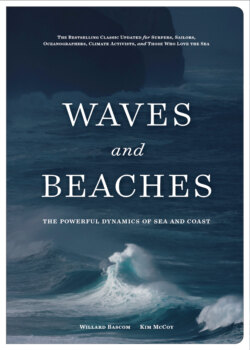Waves and Beaches

Реклама. ООО «ЛитРес», ИНН: 7719571260.
Оглавление
Kim McCoy. Waves and Beaches
Dedication
CONTENTS
Preface to the Third Edition
Prologue
UNITS AND VARIABLES USED IN THIS EDITION
1Genesis of Land, Water, and Waves
THE EARTH AND ITS WATERS
THE WAVE SPECTRUM
THE EDGE OF THE LAND
BEACHES AS MAJOR COASTAL FEATURES
THE LONGEST WAVE
2Ideal Waves
THE FIRST WAVE THEORY
THE FUNDAMENTAL PROPERTIES OF WAVES
ORBITAL MOTION
MASS TRANSPORT
THE FORCES OF GRAVITY, BUOYANCY, AND VISCOSITY
3Wind Waves
SEA WAVES
GREAT STORM WAVES
ROGUE WAVES
INTERNAL WAVES
OIL, WAVES, AND ICE ON TROUBLED WATERS
SWELL
4Waves in Shallow Water
REFLECTION
DIFFRACTION
REFRACTION
WAVES IN SHALLOW WATER
TRAPPED WAVES
STORM SURGES
THE WAVE CHANGING US ALL
5Winds and Waves of Climate Change
SEA LEVEL
HARNESSING THE POWER OF WAVES
INTERACTIONS OF ATMOSPHERE, OCEANS, AND HUMANS
6Tides and Seiches
THE TIDES
TIDAL BORES
SEICHING
CAUSES OF SEICHING
HARBORS AND SEICHES
TIDAL POWER
7Impulsively Generated Waves
SEISMIC SEA WAVES
TSUNAMI WARNING SYSTEMS
EXPLOSION-GENERATED WAVES
WAVES PRODUCED BY SHIPS
8Measuring and Making Waves
WAVE OBSERVATIONS
TIDE GAUGES
WAVE RECORDERS
THE USE OF LIGHT (OPTICAL)
THE USE OF RADIO
THE USE OF SOUND
WAVE-FORCE MEASUREMENT
MAKING WAVES
TRANSFORMING WAVES INTO KNOWLEDGE
9The Surf
BREAKING WAVES
SURF BEAT
UNDERTOW AND RIP CURRENTS
SURVEYING PIONEERS IN THE SURF
SURFING SCIENCE
10Beaches: Where the Surf Meets the Sediment
BEACH MATERIALS
SAND MOTION
BERMS AND BARS
MINOR BEACH FEATURES
FAMOUS BEACHES OF THE WORLD
WAVES OF PLASTICS
11The Conveyor Belts of Sand
SHORELINE EROSION
THE LONGSHORE TRANSPORT OF SAND
LITTORAL DRIFT
CURIOUS SAND FORMS
TIDAL ENTRANCES AND BOTTOM FEATURES
GROINS AND BEACH NOURISHMENT
DEAMS, RIVERS, AND DELTAS
DAMS
RIVERS
DELTAS
12Man Against the Sea
WAVES ATTACK
MAN DEFENDS
THE DESIGN OF SHORELINE STRUCTURES
THE HUMBOLDT BAY JETTIES
THE DUTCH MAESLANTKERING STORM-SURGE BARRIER
OFFSHORE STRUCTURES AND SHIPS AT SEA
Hydrocarbons (gas and oil)
Windfarms
Cables and Pipelines
SHIP MOTIONS, STABILITY, AND LOSSES
Why Ships Sink
Lessons from History
Epilogue
Appendix A
Appendix B
Further Reading
Endnotes. Chapter 1: Genesis of Land, Water, and Waves
Chapter 2: Ideal Waves
Chapter 3: Wind Waves
Chapter 4: Waves in Shallow Water
Chapter 5: Winds and Waves of Climate Change
Chapter 6: Tides and Seiches
Chapter 7: Impulsively Generated Waves
Chapter 8: Measuring and Making Waves
Chapter 9: The Surf
Chapter 10: Beaches: Where the Surf Meets the Sediment
Chapter 11: The Conveyor Belts of Sand
Chapter 12: Man Against the Sea
Glossary
Acknowledgments
About the Author
Index
Отрывок из книги
For Anitra, Rodney, Sarah, Austin, Madelyn, Nico,
The Maltese Islands,
.....
A beach is an accumulation of rock fragments subject to movement by ordinary wave action. A tide will extend the process up and down a beach face. Beaches may be composed of any kind or color of rocky material, ranging in size from boulders to fine sand. Because most of the beach material along the most heavily populated part of the US coast consists of a light-colored sand—which is created as a result of the weathering of granitic rock into its two main constituents, quartz and feldspar—most of us tend to think of beaches as stretches of white sand. Some white beaches in Florida are made of finely sorted quartz sand as in Destin, Florida, whereas others are composed of carbonates: by-products from the waves grinding up coral reefs, shells, and other organisms. But many Pacific island beaches are made of black sand, formed by the disintegration of dark volcanic rocks. Many English beaches are composed of small flat stones called shingle, formed from the destruction of sea cliffs made of sedimentary rock, and many Alaska beaches consist of large cobbles. And for a hundred miles along the coast of Baja California, Mexico, the beach (see photo above) is made of two materials: a flat sandy portion that is exposed only at low tide, while immediately above and behind the sand, great cobble ramparts rise to a height of 30 feet (10 m) or more. Our idea of a beach depends on what we have been exposed to. In this book, for convenience, all beach material will be called sand, although it is recognized that all the features described may be formed in pebbles or shingle or cobbles. We will not, however, explore in detail the complex study of sand, its composition, grain sizes, and mechanisms of formation, as it is outside of the scope of this book.
In Baja California each high tide erodes the cliff, permitting endless waves to churn cobbles into sand. Baja California, Mexico. Kim McCoy
.....